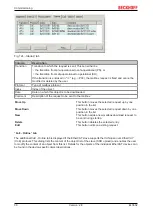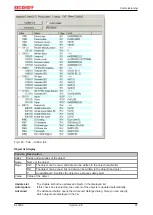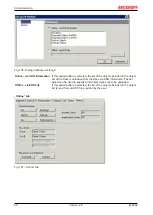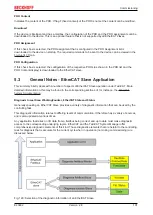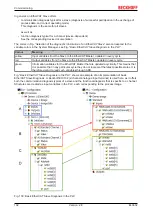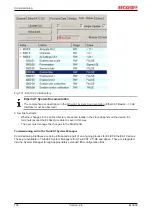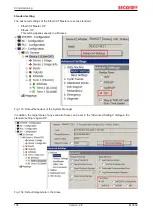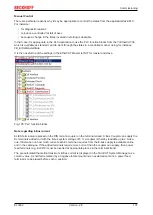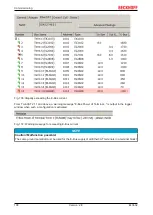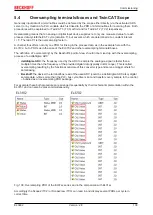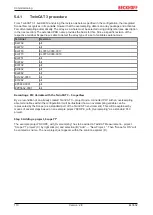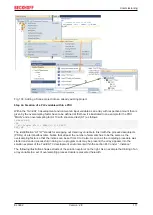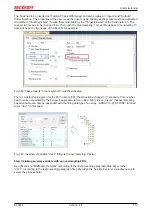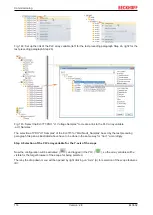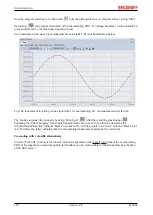
Commissioning
EL3632
103
Version: 2.8
The following aspects are covered here:
Code
Function
Implementation
Application/evaluation
A
The EtherCAT Master's diagnostic infor-
mation
updated acyclically (yellow) or provided
acyclically (green).
At least the DevState is to be evaluated for
the most recent cycle in the PLC.
The EtherCAT Master's diagnostic informa-
tion offers many more possibilities than are
treated in the EtherCAT System Documenta-
tion. A few keywords:
• CoE in the Master for communication
with/through the Slaves
• Functions from
TcEtherCAT.lib
• Perform an OnlineScan
B
In the example chosen (EL3102) the
EL3102 comprises two analogue input
channels that transmit a single function
status for the most recent cycle.
Status
• the bit significations may be
found in the device
documentation
• other devices may supply
more information, or none
that is typical of a slave
In order for the higher-level PLC task (or cor-
responding control applications) to be able to
rely on correct data, the function status must
be evaluated there. Such information is
therefore provided with the process data for
the most recent cycle.
C
For every EtherCAT Slave that has cyclic
process data, the Master displays, using
what is known as a WorkingCounter,
whether the slave is participating success-
fully and without error in the cyclic ex-
change of process data. This important, el-
ementary information is therefore provided
for the most recent cycle in the System
Manager
1. at the EtherCAT Slave, and, with
identical contents
2. as a collective variable at the
EtherCAT Master (see Point A)
for linking.
WcState (Working Counter)
0: valid real-time communication in
the last cycle
1: invalid real-time communication
This may possibly have effects on
the process data of other Slaves
that are located in the same Syn-
cUnit
In order for the higher-level PLC task (or cor-
responding control applications) to be able to
rely on correct data, the communication sta-
tus of the EtherCAT Slave must be evaluated
there. Such information is therefore provided
with the process data for the most recent cy-
cle.
D
Diagnostic information of the EtherCAT
Master which, while it is represented at the
slave for linking, is actually determined by
the Master for the Slave concerned and
represented there. This information cannot
be characterized as real-time, because it
• is only rarely/never changed,
except when the system starts up
• is itself determined acyclically (e.g.
EtherCAT Status)
State
current Status (INIT..OP) of the
Slave. The Slave must be in OP
(=8) when operating normally.
AdsAddr
The ADS address is useful for
communicating from the PLC/task
via ADS with the EtherCAT Slave,
e.g. for reading/writing to the CoE.
The AMS-NetID of a slave corre-
sponds to the AMS-NetID of the
EtherCAT Master; communication
with the individual Slave is possible
via the
port
(= EtherCAT address).
Information variables for the EtherCAT Mas-
ter that are updated acyclically. This means
that it is possible that in any particular cycle
they do not represent the latest possible sta-
tus. It is therefore possible to read such vari-
ables through ADS.
NOTE
Diagnostic information
It is strongly recommended that the diagnostic information made available is evaluated so that the applica-
tion can react accordingly.
CoE Parameter Directory
The CoE parameter directory (CanOpen-over-EtherCAT) is used to manage the set values for the slave
concerned. Changes may, in some circumstances, have to be made here when commissioning a relatively
complex EtherCAT Slave. It can be accessed through the TwinCAT System Manager, see Fig.
“EL3102,
CoE directory”
:








